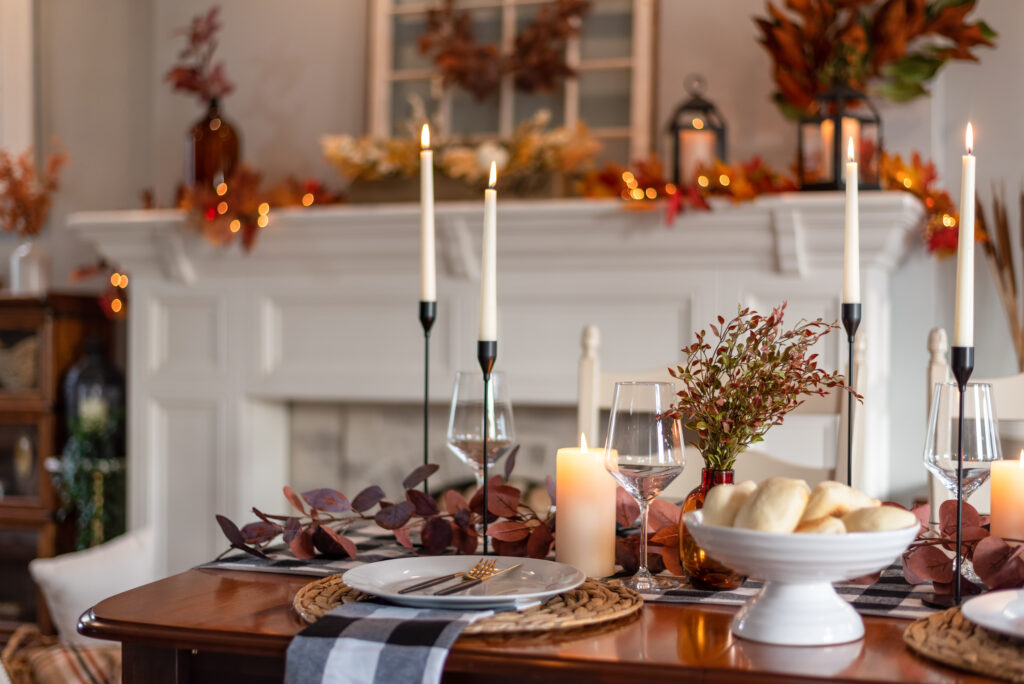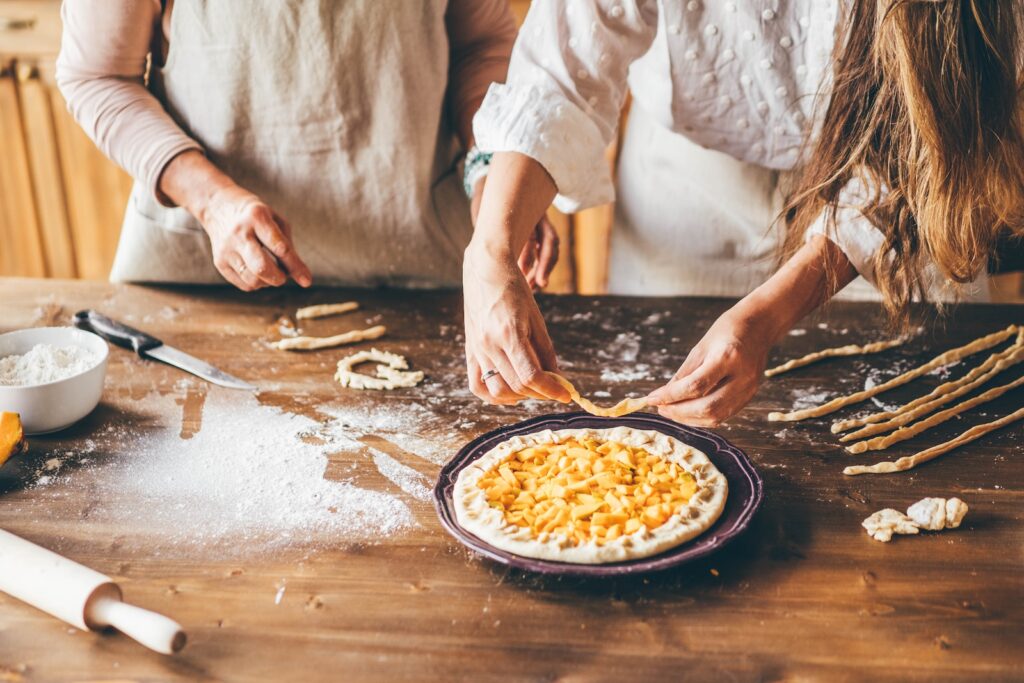Every family has a Thanksgiving origin story. Some begin with a grandmother’s battered recipe card, others with a shaky first attempt at gravy. But mine began, this year, with a text from Grace.
Grace, who I once buckled into a car seat and bribed with Goldfish crackers, is now somehow a fully grown human capable of managing a stovetop, wrangling guest lists and hosting a whole Thanksgiving dinner without an adult supervising from three feet away. Time is a wheel of brie my friends; it just keeps rolling.
Her question —”Can cooking all day actually be fun?” — got me thinking. If Grace was staring down her holiday meal with equal parts courage and bewilderment, surely others were too. So I put out a call: send me your Thanksgiving quandaries, your culinary existential crises, your “is this normal?” kitchen confessions. And you did. You wrote in from inboxes and DMs and social feeds with questions about everything from drink quandaries to annoying cousins.
And I just want to say, before we get to answering them, how deeply, truly, grateful I am for all of it — not just the questions, but the quiet, sustaining community that has grown around “The Bite,” the weekly food newsletter for Salon where these questions were first published.
Knowing readers are out there cooking and thinking alongside me is a gift I don’t take lightly. Yet every time I sit down to write “The Bite,” it feels less like sending something out into the void and more like pulling up an extra chair to a table I’m lucky to share. So, before the great grocery store pilgrimage begins, before any of us commits to peeling a single potato, let’s begin. Here are your questions — and, I hope, answers that make the holiday feel a little lighter.
This is my first year hosting! Do you have any tips for making cooking all day … actually fun? (IDK, can it be fun?) I want to keep doing this in the future so I want it to be a good experience! — Grace from Lexington

(LumiNola/ Getty Images) Lighting candles on the Thanksgiving table
First of all, Grace: congratulations on your inaugural hosting year! That’s a big emotional swing, and a tender one. I’m sure you’ll do great. And yes — the answer is absolutely, wholeheartedly yes — cooking all daycanbe fun. Not performatively fun, not “I’m smiling through gritted teeth” fun, but genuinely pleasurable, in that way long projects can feel when the rhythm carries you.
Here’s the honest bit: your first Thanksgiving is not necessarily the moment to chase the adrenaline high of marathon meal prep. That’s line-cook joy, kitchen–brigade joy — a very specific, slightly masochistic ecstasy that tends to belong to people who’ve burned off their fingerprints on sauté pans. I’d say you deserve something gentler.
So, lighten the load. Not everything needs to be hand-mashed, hand-baked, hand-whisked into perfection. Store-bought is not a concession; it’s a strategy. Your local bakery almost certainly makes pies that look like they’ve been lifted from a vintage cookbook illustration. The good grocery store can handle your pre-dinner snack spread far more gracefully than a last-minute veggie tray. And that barbecue joint you love? I would bet an entire wishbone they’re slinging pans of macaroni and cheese that will bring the house down. Outsourcing, wisely done, doesn’t diminish your meal — it scaffolds it.
Then: give yourself the gift of a little gentle structure. I know this sounds like the gospel of a very specific personality type — I nurse an ardent Filofax obsession and once started an organization Slack channel purely for sport — but there’s something deeply calming about a simple binder. Truly. Print out your recipes. Make your grocery list and your cooking timeline (note when you’re picking up anything pre-made). Scribble down your guest list with dietary quirks. It’s not overkill; it’s future-you leaving breadcrumbs for next year’s you. A time capsule of competence.
On the day itself, honor the physicality of cooking. Eat breakfast, something sustaining and easy. This is not the moment to run on fumes or holiday excitement alone. Hydrate like you’re training for a marathon. Personally, I save the wine for the actual meal; I’ve sustained enough culinary battlefield injuries while completely sober, thank you very much.
And then — the heart of the matter — curate a vibe. This is what transforms labor into pleasure. Put on music that makes the morning feel lit from within. Wear something soft and forgiving until it’s time to change. Take delight in the cook’s little privileges: the crisp edge of turkey skin you sneak while no one’s looking, the warm spoonful of gravy that tastes like a secret, the first cloud of freshly whipped cream. These tiny moments are the real feast.
If you let them, they’ll carry you through the day. And, with any luck, straight into next year. Good luck!
This year, things are tight (that’s an understatement, right?) and I’m spending most of my holiday budget on the meal itself. How can I make my place and the dinner table feel cozy and festive without dedicating huge money to seasonal decor? — Melissa in Austin

(Alina Rudya/ Bell Collective/ Getty Images) Dinner table decorated for cozy fall holiday gathering
Hosting on a budget is a rite of passage, I think—a kind of domestic apprenticeship where you suddenly realize that ambience is not something you can buy in the seasonal aisle. While I’m usually staunchly opposed to asking, “How would a restaurant do this?” (dinner parties and restaurants are entirely different planets of experience; comparing them feels like comparing a handwritten letter to a press release), there is something useful in paying attention to what makes a good neighborhood restaurant feel good.
Because here’s the secret: it’s rarely the décor you haul out once a year, the turkey-shaped anything, or the glittery garlands destined for a January trash bag. What lingers in the mind is much simpler—small sensory cues that quietly tell your body, you’re welcome here.
There’s a local spot I’ve mentioned before—Dove’s Luncheonette—and every time I’m there, I think, “Why can’t my apartment feel like this?” Not the menu, necessarily, but the way they choreograph comfort. The host stand has a bowl of custom matchbooks; the check arrives with a hand-illustrated postcard they’ll mail for a dollar. The soundtrack is actual vinyl—crackly, charming, blessedly free of Spotify commercials for paper towels. The lights blur the room just enough to make everyone look like they got a full night’s sleep. When fall rolls around, they loop a simple garland of leaves around the bar—nothing fancy, just a whisper of the season. Even the bathroom soap smells like someone thought about it for longer than five seconds.
Add in a bowl of pozole roja or thick Texas toast dripping with butter and jam, and suddenly you’re in multisensory heaven.
Holidays at home, by contrast, can feel… harsh. The overhead lights glare. The TV blares a gold-coin commercial no one asked for. The air wafts with the scent of three days of cooking (and maybe a few relatives voicing strong opinions about said cooking). It’s a lot.
So start small. Think about the senses you can gently dial up or down. If the game isn’t on, put on a record or a playlist that feels like a warm hand on your shoulder. Bring in a few unscented candles to help the room exhale a little. On the stove, set a tiny simmer pot—some cinnamon sticks, citrus peel, a rosemary sprig, a splash of water—to give the house a soft, cozy scent without overwhelming the food.
Layer in a few tactile moments: handwritten menus or place cards if that’s your vibe, or simply a stack of good blankets and genuinely comfortable pillows for that glorious post-meal sprawl on the couch. These details don’t cost much, but they whisper the same message:you’re cared for; linger awhile.
What drink (or drinks?) should I actually be serving with Thanksgiving dinner? Do I need to provide a variety of alcoholic and non-alcoholic options for people to choose? One of each? Pair with courses? — David in Chicago

(Alina Rudya/ Bell Collective/ Getty Images) Thanksgiving drinks
In my world, adult Thanksgivings have become a kind of beverage Venn diagram where no circles overlap. You’ve got the sober-curious friend, the cousin who talks about pét-nat like it’s a religion, the granddad who believes football season requires a beer in hand and nothing else, ever. Which is why I’ve come to swear by a three-part drinks strategy that feels both streamlined and generous: a little choreography that keeps everyone content without turning you into the household beverage director.
Before dinner
There’s a delicious little window between arrivals and the meal itself—a liminal pocket of time that begs for something bubbly and welcoming. Go for a batchable non-alcoholic cocktail: your signature mocktail moment. I like anything effervescent and not too sweet, ideally ladled from a punch bowl because punch bowls inherently make adults feel like children in the best possible way.
A favorite from a few years back: a heavy pour of local apple cider, the juice of a lemon, the juice of an orange, enough Topo Chico to make the punch bowl hiss, and citrus-herb ice cubes—twigs of rosemary, wheels of citrus, frozen in place like tiny stained-glass windows. It’s high visual impact, low lift, and everyone can drink it.
With dinner
This is where you keep things delightfully simple. Water glasses for all, of course — still or sparkling. Both are lovely, but one is truly enough.
If your family leans wine, pick a single bottle that actually suits the meal: something crisp and acidic like a zippy Sauvignon Blanc, a light-bodied floral Beaujolais or even a gently funky orange wine. Then grab a comparable non-alcoholic option (I’m very fond of several from Non—they do complexity without leaning syrupy).
If your people are beer people, think versatile: an amber ale or clean lager, plus a solid N/A counterpart.Athletic makes good ones, though many skew hoppy, so keep your audience in mind.
Basically: aim for a one-to-one ratio of alcoholic to non-alcoholic choices, and keep the lineup short. You’re feeding people, not running a bar program.
After dinner
This is the moment where so many Thanksgiving tables lose the thread. You’ve made this gorgeous meal and then—nothing.But a thoughtful after-dinner drink is such a gentle pleasure. Personally, I think it should almost always be coffee: the aromatics alone become a bridge from turkey and stuffing to pie and whipped cream.
Brew a fresh pot with good beans. Set out a few small luxuries—cream or oat milk, maple syrup, cinnamon—and let people build their perfect cup.A simple, old-fashioned coffee-and-dessert bar feels charming, cozy and complete. The kind of ending that lets everyone exhale.
I have hosted family Thanksgiving for the last decade and ask this, semi-lovingly, with a particular cousin in mind: What do I say when someone insists on helping in the kitchen, but actually makes things worse? We’re talking burning dishes they forgot to take out of the oven and, once, a cut hand that almost resulted in going to the ER! This has been going on for years! It feels ridiculous, but I also don’t want to cause a scene or hurt feelings. — Anonymous

(Maria Korneeva / Getty Images) Mother and adult daughter baking pumpkin pie together at home.
Ah, yes. The overeager holiday helper — that perennial character in the Thanksgiving tableau. They materialize in the kitchen year after year, radiating earnest goodwill, and yet somehow leave a trail of small calamities in their wake. A scorched casserole here, a mysteriously missing oven mitt there and that one unforgettable afternoon when a forgotten paring knife and a moment of bravado nearly sent you both to the ER. It’s almost cinematic in its predictability.
But here’s the secret that makes this dynamic feel less maddening: people drift into the kitchen for very different reasons. Some are hardwired to pitch in; their hands feel itchy if they’re not chopping something. Others flee there because they don’t quite know what to say in the living room and need a task to justify their presence. Still others — and this may be your cousin — simply want to be near the action, hovering like an enthusiastic stagehand hoping for a cameo. Understanding which category your cousin falls into can help you strategize long before the turkey hits its final internal temp.
If they’re the socially anxious mingler, give them a soft landing outside the kitchen: a sprawling 1,000-piece puzzle with a painterly scene; a set of elegant adult coloring sheets; a beautiful Audubon matching game with delicately illustrated birds; or even a few old-school metal brainteasers that make people hum thoughtfully to themselves. Create a little annex of contemplative delight in the living room — somewhere to land with a drink and a snack and not feel adrift. Often, that’s all someone like this really needs.
But if your cousin is the type who truly wants to contribute — who wants the feeling of being useful without, you know, wielding a chef’s knife in a crowded room — then yes, of course you can say “no.” No is a whole sentence, and a heroic one at that. But you can also borrow a page from the “yes, and” playbook to redirect their energy with grace. Typically thought of as a core tenet of improv comedy, author Kendra Adachi recommended it as a hosting posture in a recent episode of her podcast and it’s astonishing how well this works on a holiday built on both chaos and choreography.
Picture it:
- “Of course —andwould you mind building a playlist for dinner? I trust your taste more than my own right now.”
- “Yes! Could you float over to the dining room and check that we’ve got the right glasses on the table?And maybe light the candles while you’re there.”
- “Totally —and actually, would you be our official Greeter? People are arriving any minute and you have the warmest vibe.”
- “Yes, please —would you refill the water pitchers so we’re set for dinner? It’s the one thing I always forget.”
It’s all about offering them a role in the production that doesn’t involve hot surfaces or sharp edges. It honors their enthusiasm, protects your kitchen equilibrium, and keeps the day humming along with the kind of gentle, slightly cinematic glow that makes Thanksgiving feel like Thanksgiving.
This story originally appeared in The Bite, my weekly food newsletter for Salon. If you enjoyed it and would like more essays, recipes, technique explainers and interviews sent straight to your inbox, subscribe here.


